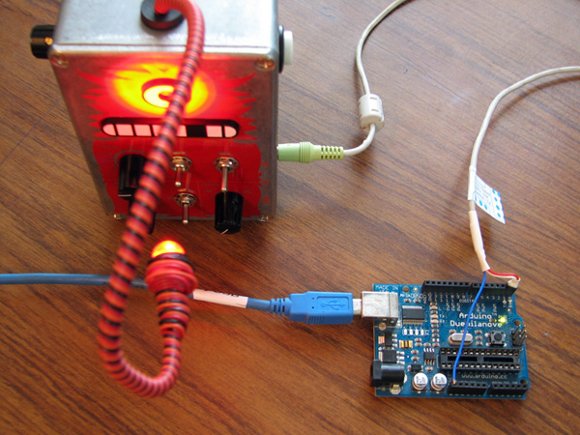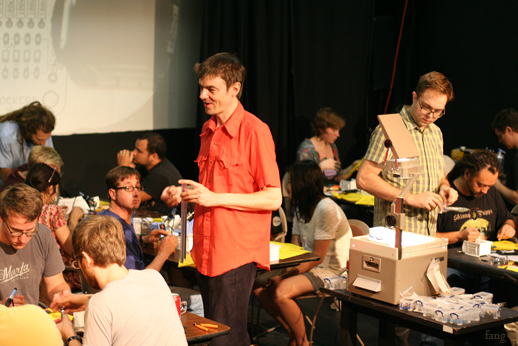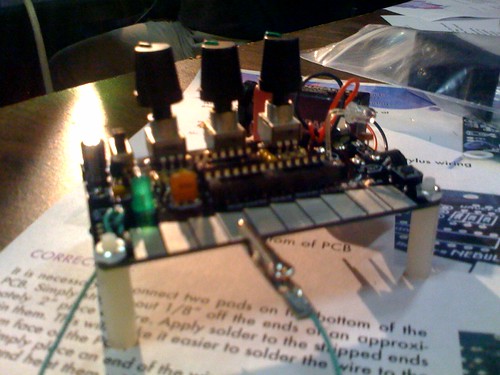Wherever you live, you can enjoy the DIY and open hardware inventions coming out of Texas. Or, as the famous song goes: “That’s right, you’re not from Texas / Texas wants you anyway.”
Austin, Texas may be associated with the strum of guitars. But it’s also populated by some of our favorite electronic music hardware inventors on the planet, led by the likes of Bleep Labs, 4ms, Eric Archer, and more. They’ve taken the idea of a “Handmade Music” and come up with the best formula for building a community around DIY hardware I’ve seen yet:
1. Get beginners – even if they’ve never soldered before – making noises with a beginning kit workshop.
2. Do an advanced workshop that pushes the envelope with new hardware.
3. Turn that noise into a performance/party: i.e., “After all the kits were built, we plugged in to the PA and partied until the amp overheated.”
4. Provide your specs and software freely.
5. Make a kit available for people to buy.
Notice that it’s possible to make “free hardware” (open sourcing part or all of the code, publishing specs and circuits) and still sell a product. And it’s possible to act locally (workshops in Austin), and sell globally (sharing documentation online, and shipping kits everywhere else).
And notice that it’s possible to make events beginner-friendly. In fact, this isn’t just to teach experienced musicians how to solder. I find that many people who are too shy to make music via traditional means find there’s a freedom to a glitchy, blippy electronic thing that makes noise. After all, through the ages music was never intended to be exclusively the domain of professional specialists.
Here’s the latest on their activities – and a chance to meet the hardware that has come out of their series.
For more, stay glued to handmademusic@noisepages.
First, let’s meet the devices:
Meet the Beasties
Thingamagoop 2

Bleep Labs’ Thingamagoop seems as much electronic creature as electronic instrument; its sounds seem like the vocalizations of an alien and, yes, it’s darned cute. The new Thingamagoop 2 is more usable (easier-to-access battery), sounds better, and has more features. But it’s also more open in every way. CV in and out lets it interface with analog gear. A programmer jack lets you reprogram it with your Arduino, if you so choose (the Arduino isn’t required, but it does let you reprogram the sounds on your Thingamagoop). And now the sonic effects — sample and hold, arpeggios, noise, and bit crush — all use open-sourced code. That makes what was already an ingenious soundmaker more open to hacking by advanced users.
The Thingamagoop 2 debuted to the world at Austin’s Handmade Music. Now, perhaps we need some hack sessions to get people working on reprogramming this and other sonic oddities.
Full info on the Thingamagoop 2
Arduino code
Circuit diagram
I expect to get one of these soon, so expect a hands-on.

Nebulophone
Nebulophone is a coming kit that builds on the Arduino platform to create a playable, DIY Stylophone-style instrument. Having debuted at Handmade Music Austin #4, the instrument features “adjustable waveforms, a light controlled analog filter, LFO, and arpeggiator that can be clocked over IR.” Yes, you read that last bit right: it’s all part of the new wireless, infrared sync revolution these guys are leading.
Official site has code, schematics, instructions – so you can actually make your own – plus sound and advance info on the coming kit. I expect a video and more on the kit soon.
SimSam
The SimSam is a noisy, glitchtastic product.
It’s also the subject of a beginners’ workshop, a chance to get people working with electronics for the very first time.
And its cost – a tiny $8 in parts.
It’s also a brilliant use of the ATTINY85, an ultra-compact, 8-pin AVR chip. (AVR chips also live at the heart of the Arduino platform.)
And the SimSam debuted at – you guessed it – a workshop at Handmade Music Austin #4.
Tons of info and everything you need to build your own:
SimSam
There are actually some details that could use improving, so have a look and see if you can do an updated version.
Autonomous Bassline Generator + Andromeda Space Rocker + MIDI-IR Sync
The Autonomous Bassline Generator…
…can sync up with drum modules like this Andromeda Mk-4 by Eric Archer:
…and sync together via infrared, wirelessly, connecting to each other or slaving to a MIDI clock signal generated by Wooster Audio’s MIDI-IR.
Together, you get the Andromeda Space Rockers: a whole little galaxy of wirelessly-synced sonic gadgets. And all of the above are available as kits, so you can sooth your soul by assembling them yourself.
The creators have debuted and jammed with these gadgets through Handmade Music, and presented workshops on the technologies and concepts that underly their creation.
Arduino, Sound Libraries, and Resources
I asked Dr. Bleep himself (John-Mike) about what resources might be useful for working with the Arduino platform (and similar architectures) and sound. The main secret is, use Pulse Width Modulation to accomplish sounds with a minimum of code:
Here are a few of the pages I used when designing the code for it:
http://www.cs.mun.ca/~rod/Winter2007/4723/notes/timer0/timer0.html
http://arcfn.com/2009/07/secrets-of-arduino-pwm.html
http://blog.wingedvictorydesign.com/2009/05/29/generate-real-time-audio-on-the-arduino-using-pulse-code-modulation/2/http://little-scale.blogspot.com/ is a fantastic source for “Oh man why didn’t i do that/ this guy is incredible!” projects.
I’m also not the first to mate the stylophone with arduino
http://hackaday.com/2009/08/25/arduino-based-synthesizer/
The two biggest/ earliest arduino synths were :
http://code.google.com/p/tinkerit/wiki/Auduinohttp://www.critterandguitari.com/home/store/arduino-piano.phpOne difference with the Nebulophone is that it is very low part count. No multipexers or DACs. Just PWM out to an two opamp analog filter. This does limit the number of keys and controls but makes for a tiny, simple pcb.
Handmade Music Austin, in Videos
How do these events go down? Here’s a look at some of the sonic mayhem.
Episode 1:
Episode 2:
Episode 3:
Handmade #4 lacks a video, but we’ll watch for #5 when it happens.
The next Handmade Music Austin is on February 28. Details aren’t up yet, but I’m told you can expect an advanced workshop on building a digital delay by Nathan/Wooster Audio, plus a simple, light-controlled noisemaker for beginners. Stay tuned to:
http://handmademusic.createdigitalmusic.com


